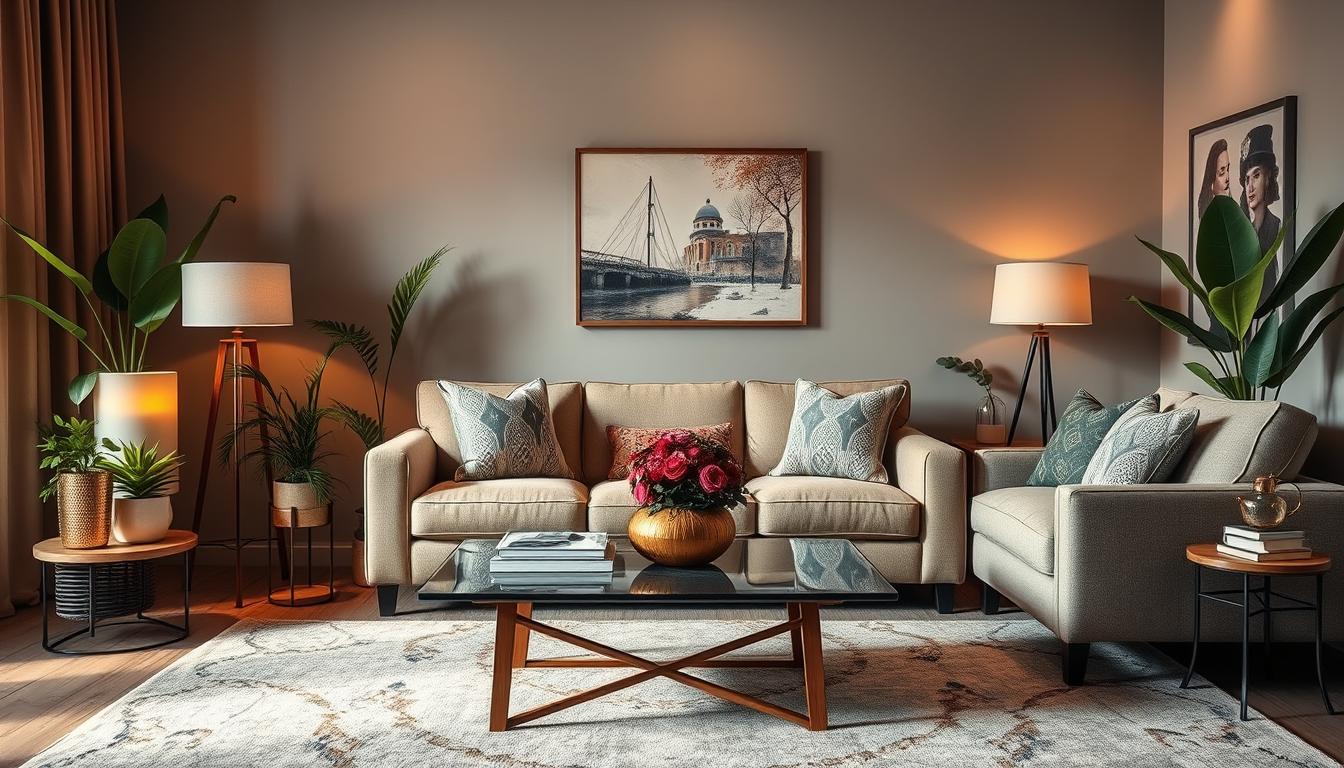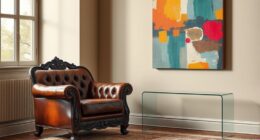Symmetry plays a powerful role in creating balanced, harmonious designs that appeal to your senses and evoke positive emotions. It provides structure and stability, making your creations feel organized and inviting. Whether in architecture, art, or interior decor, mastering symmetry helps you craft visually pleasing compositions that communicate meaning and cultural symbolism. By understanding how symmetry guides the eye and influences feelings, you’ll discover how to enhance your designs for a truly harmonious look. Keep exploring to discover more insight.
Key Takeaways
- Symmetry creates visually appealing and balanced designs that promote harmony and stability.
- Incorporating color theory with symmetry enhances emotional impact and viewer engagement.
- Symmetrical patterns and proportions evoke feelings of calmness, security, and unity.
- Thoughtful use of symmetry in architecture and art guides focus and emphasizes key elements.
- Combining symmetry with complementary textures and lighting fosters a cohesive, harmonious aesthetic.
Understanding the Principles of Symmetry in Design
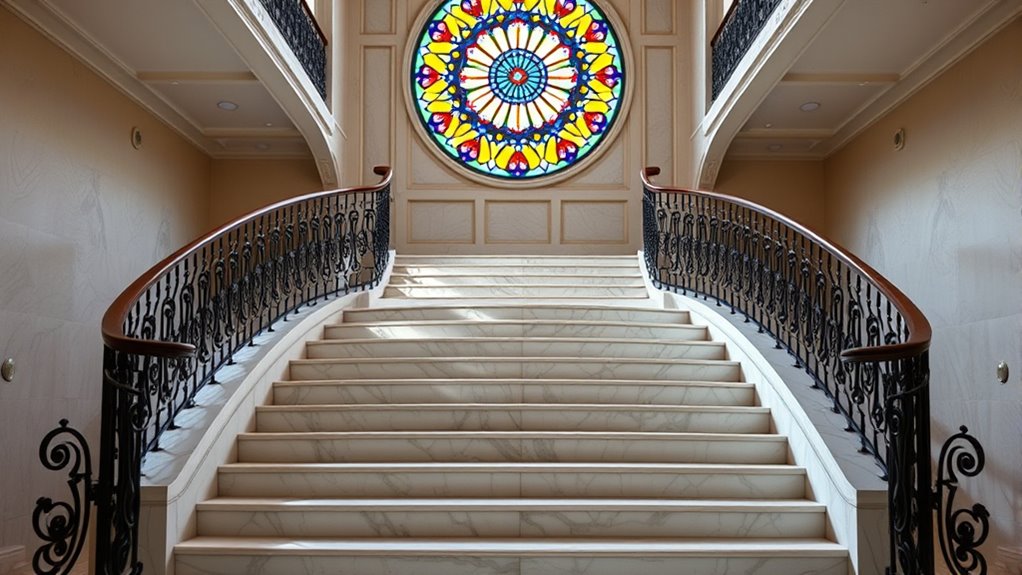
Symmetry plays an essential role in creating visually appealing and balanced designs. When you understand how symmetry works, you can effectively use color theory to enhance harmony, choosing colors that mirror each other or balance across the composition. Cultural symbolism also influences symmetry choices; different cultures assign unique meanings to symmetrical patterns, impacting how viewers interpret your work. For example, in some cultures, symmetrical designs symbolize harmony and unity, while in others, they represent spiritual balance. Recognizing these cultural nuances helps you craft designs that resonate deeply with diverse audiences. By mastering the principles of symmetry, you guarantee your compositions are not only pleasing to the eye but also meaningful, leveraging color and symbolism to reinforce your message. Additionally, understanding Cultural Intelligence enables designers to adapt their use of symmetry to align with cultural preferences, ensuring their work connects authentically with global audiences.
The Psychological Impact of Balanced Compositions

When you look at balanced compositions, you often feel a sense of calmness and stability that puts your mind at ease. These designs are also more attractive because they align with your natural preferences, making them more appealing. As a result, your emotional responses tend to be positive and consistent, reinforcing the power of balance in visual communication. The human brain naturally responds to harmonious soundscapes, which can evoke similar feelings of tranquility and engagement.
Calmness and Stability
Balanced compositions inherently evoke a sense of calmness and stability because they align with our natural preference for order and predictability. When you incorporate nature-inspired patterns, such as symmetrical leaves or flowing water, you reinforce this feeling of harmony. These patterns remind us of the natural world’s inherent balance, soothing our minds. Cultural symbolism also plays a role; symbols like mandalas or balanced motifs carry meanings of protection and unity, further enhancing a sense of security. By using symmetry, you create a visual rhythm that reassures viewers, reducing anxiety and fostering peace. This psychological impact makes balanced designs especially effective in spaces where tranquility and stability are desired, helping you establish environments that feel grounded and harmonious. Additionally, understanding the emotional response triggered by balanced visuals can deepen the connection between design and viewer, amplifying the calming effect.
Perceived Attractiveness
Balanced compositions naturally draw the eye and create a sense of visual harmony, making them appear more attractive to viewers. When your design feels orderly, it appeals to our innate preference for stability. Elements like color harmony reinforce this effect, ensuring colors complement each other and enhance overall balance. Additionally, cultural symbolism influences perception, as familiar shapes and motifs evoke positive associations. Consider this table illustrating different balanced elements:
| Element | Effect |
|---|---|
| Color harmony | Creates visual unity and calmness |
| Symmetry | Builds a sense of order |
| Cultural symbols | Elicit subconscious positive feelings |
| Composition layout | Guides the viewer’s eye smoothly |
Together, these factors heighten perceived attractiveness, making your design more engaging and pleasing. Incorporating rustic lighting and vintage furniture further enhances the charm, creating a timeless appeal that fosters a harmonious environment.
Emotional Response Patterns
Have you ever wondered why certain designs evoke strong emotional responses? It’s because balanced compositions tap into your subconscious perceptions, creating feelings of comfort and harmony. Symmetry and proportion influence your emotional reactions without you realizing it, often making designs feel pleasing or trustworthy. When elements are balanced, your mind perceives stability and order, which fosters positive feelings. Conversely, unbalanced designs can trigger discomfort or unease. These subconscious perceptions shape your overall experience, guiding how you respond emotionally. By understanding these emotional response patterns, you can craft visuals that resonate deeply, encouraging engagement and connection. In fundamental terms, balanced designs don’t just look good—they actively influence your mood and perceptions on a psychological level. Additionally, research supports the idea that predictive validity of certain design principles can enhance viewer perceptions and responses.
Symmetry in Architectural Structures

Why is symmetry so prevalent in architectural structures? It creates a sense of order, stability, and beauty that appeals universally. Symmetry often reflects nature motifs, like the balanced wings of a butterfly or the mirrored leaves of a plant, reinforcing harmony. It also embodies cultural symbolism, representing ideals like perfection and unity across societies. You’ll notice symmetrical designs in grand cathedrals, temples, and palaces—they evoke awe and reverence. Symmetry also guides the viewer’s eye smoothly across a structure, emphasizing its importance. Additionally, growth patterns in nature demonstrate the natural inclination toward symmetry, inspiring architects to incorporate these principles into their designs.
Achieving Harmony With Symmetrical Interior Decor
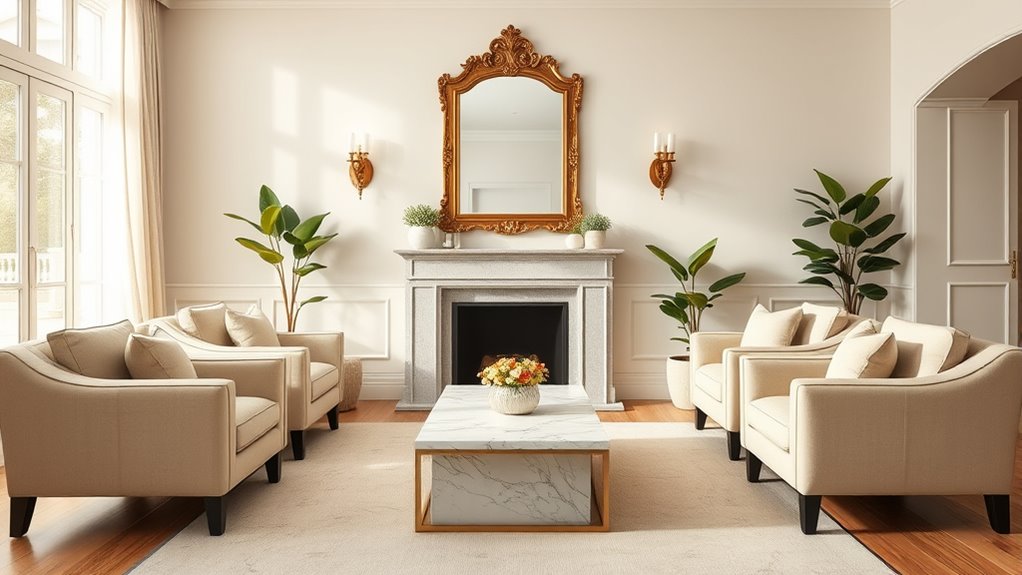
To create a harmonious interior with symmetry, start by carefully arranging furniture and decor so that each side mirrors the other. Achieve color harmony by selecting a cohesive palette, using complementary or matching shades on both sides to enhance balance. Material selection also plays a crucial role; choose similar textures and finishes for furniture and accessories to create a unified look. For example, pairing wood with wood or metal accents with other metallic elements maintains consistency. Keep proportions in mind, ensuring that mirrored pieces are similar in size and weight to avoid visual imbalance. Paying attention to these details helps in creating a balanced environment that feels more organized and peaceful. Symmetry combined with thoughtful color and material choices fosters a balanced, inviting atmosphere.
Using Symmetry to Create Focal Points in Art and Photography

You can draw attention to a subject by placing it centrally, making it the natural focal point. Mirroring techniques, like repeating elements on either side, reinforce the sense of balance and guide the viewer’s eye. Emphasizing symmetrical balance helps you create compelling compositions that feel both harmonious and engaging.
Central Placement Strategies
Central placement strategies leverage symmetry to draw viewers’ attention directly to the focal point in art and photography. By positioning your subject at the center, you create an immediate visual impact that guides the eye effortlessly. To enhance this effect, consider color harmony—using complementary or analogous shades to make the focal point stand out. Texture variation also plays a key role; contrasting smooth and rough surfaces adds depth and interest. Symmetry ensures balance, making the composition feel harmonious and stable. Keep in mind that subtle adjustments in lighting and framing strengthen the central placement. Additionally, understanding contrast ratio helps in selecting lighting conditions that make the central element pop. When executed thoughtfully, these strategies create an engaging, unified image that naturally directs attention to your intended focal point.
Mirroring Techniques Effectively
Mirroring techniques harness symmetry to draw viewers’ eyes directly to the focal point, creating a balanced and harmonious composition. You can achieve this by carefully aligning elements so that pattern repetition guides attention naturally. Use color harmony to emphasize the mirrored areas, ensuring that the repeated patterns or shapes complement each other and reinforce the overall balance. When applying mirroring, think about how the symmetry frames your focal point, making it stand out without overwhelming the scene. This technique invites viewers to explore the artwork or photograph, encouraging a visual journey centered around your intended highlight. By combining pattern repetition with strategic use of color harmony, you create a compelling, unified design that captures and holds attention effortlessly. Additionally, understanding core personality traits can help artists and photographers tailor their compositions to evoke specific emotional responses from viewers.
Emphasizing Symmetrical Balance
Have you ever noticed how symmetrical elements naturally draw your eye to a specific point in artwork or photography? Symmetry helps emphasize focal points by guiding viewers’ attention directly. You can highlight nature motifs, like mirrored landscapes or floral patterns, to create harmony. Cultural symbolism also plays a role; balanced compositions often reflect traditions and beliefs, making the artwork more meaningful. To emphasize symmetrical balance effectively, consider:
- Using central placement of key subjects
- Incorporating repeating patterns for rhythm
- Highlighting cultural symbols as anchors
- Balancing visual weight across axes
- Employing natural motifs to evoke familiarity
Additionally, incorporating crochet styles for locs can add creative symmetry to personal fashion, enhancing the overall harmony of your look.
The Role of Asymmetry in Complementing Symmetrical Designs

While symmetrical designs create a sense of harmony and stability, incorporating asymmetry can introduce visual interest and dynamic energy. You can achieve asymmetry balance by intentionally offsetting elements, which creates visual tension without disrupting overall harmony. This tension draws the viewer’s eye and keeps the design engaging. Asymmetry works well when you want to highlight specific areas or create focal points, adding depth and personality to your work. When used thoughtfully, it complements symmetry by breaking predictability and adding a layer of complexity. The key is to maintain a sense of intentional imbalance that feels purposeful rather than chaotic. This interplay between symmetry and asymmetry results in a balanced design that feels both stable and lively, capturing attention and evoking interest.
Techniques for Incorporating Symmetry in Graphic Design
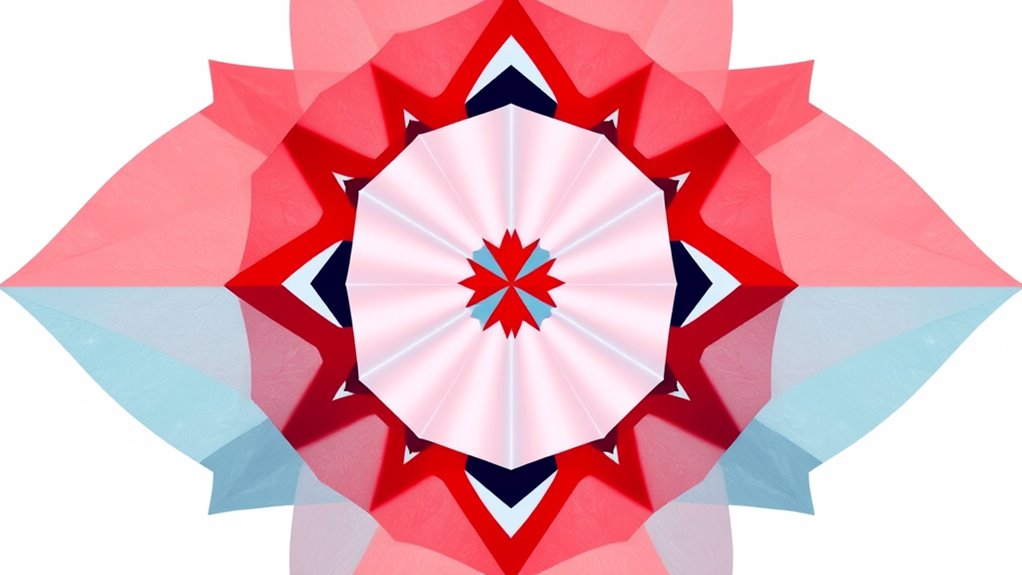
You can create striking designs by using mirror imaging techniques to reflect elements across an axis, establishing balance effortlessly. Radial symmetry methods, where elements radiate from a central point, also add harmony and visual interest. Combining these techniques helps you craft cohesive and compelling compositions that draw viewers in.
Mirror Imaging Techniques
Mirror imaging techniques are powerful tools for creating striking symmetry in graphic design. They allow you to duplicate and flip elements, producing a balanced and harmonious look. When you incorporate nature patterns, this method emphasizes organic symmetry found in leaves, flowers, and landscapes. It also highlights cultural symbolism, where mirrored motifs often carry deep meaning in various traditions. To effectively use this technique, consider:
- Selecting elements with inherent symmetry
- Mirroring patterns for visual balance
- Using cultural motifs as central focal points
- Combining natural and cultural patterns cohesively
- Ensuring the mirrored image aligns perfectly for seamlessness
Radial Symmetry Methods
Have you considered how radial symmetry can create dynamic focal points in your designs? By using techniques inspired by nature patterns and cultural motifs, you can craft eye-catching visuals that draw viewers inward. Circular arrangements of elements, such as floral patterns or mandalas, emphasize balance and harmony, making your design feel unified. Incorporate repetitive motifs that radiate from a central point to evoke a sense of movement and energy. You can also blend cultural symbols with natural elements to add depth and cultural resonance. Radial symmetry methods help you craft intricate designs that captivate attention and evoke emotional responses. Whether designing logos, backgrounds, or decorative accents, this approach guarantees your work feels harmonious and visually engaging.
Common Mistakes to Avoid When Using Symmetry
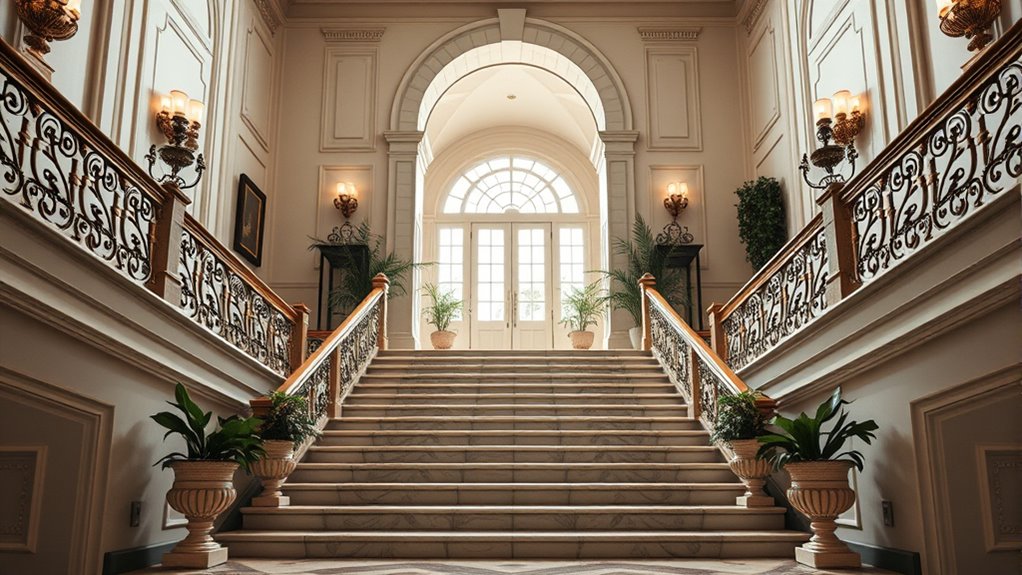
When implementing symmetry in design, it’s easy to fall into common pitfalls that can undermine the intended balance. One major issue is ignoring asymmetry pitfalls that create visual confusion. Overusing symmetry can lead to imbalance mistakes, making a space feel static or stiff. You might also misalign elements, disrupting harmony. Relying solely on perfect mirror images can make a design look dull or predictable. Additionally, neglecting variety within symmetrical layouts can cause monotony. To conclude, failing to consider the overall flow can result in a cluttered appearance.
- Over-symmetrizing without variation
- Ignoring asymmetry pitfalls for visual interest
- Misaligning key elements
- Overlooking the importance of focal points
- Creating an overly rigid or boring design
Case Studies: Successful Applications of Symmetrical Design

Successful symmetrical designs demonstrate how balance can enhance aesthetics without becoming dull or predictable. Nature patterns, like the symmetry of butterfly wings or leaf arrangements, showcase how harmony in design creates visual appeal and natural elegance. These patterns inspire architects and artists to replicate such balance, resulting in stunning structures and artworks. Musical compositions also rely on symmetry to evoke harmony and emotional resonance. Repeating motifs, mirrored melodies, and balanced rhythms create a sense of order and beauty that captivates audiences. By studying these real-world examples, you see how symmetry fosters a sense of stability and aesthetic appeal. Whether inspired by nature or music, successful symmetrical designs prove that balance can elevate visual impact without sacrificing interest or complexity.
Tips for Balancing Symmetry With Dynamic Elements

To effectively balance symmetry with dynamic elements, you need to introduce contrast without disrupting harmony. Use color contrast to highlight focal points or create visual interest, ensuring vibrant hues don’t overpower the overall balance. Incorporate texture variation—mix smooth and rough surfaces—to add depth and tactile appeal. Keep dynamic elements proportional to maintain symmetry, avoiding clutter or imbalance.
Consider these tips:
- Use bold color contrast sparingly for impact
- Mix textures to enhance visual interest
- Place dynamic features asymmetrically for subtle tension
- Keep scale consistent to preserve harmony
- Use lighting to emphasize contrasting elements
Frequently Asked Questions
How Does Symmetry Influence User Experience in Digital Interfaces?
Symmetry greatly influences your user experience by creating visual balance, making interfaces feel organized and easy to navigate. When a design is symmetrical, it fosters user trust because it appears professional and reliable. You’re more likely to stay engaged and feel comfortable exploring the interface, knowing that the symmetry signals thoughtful design. Overall, symmetry helps you enjoy a harmonious, intuitive digital experience that boosts confidence and satisfaction.
Can Symmetry Be Effectively Used in Minimalist Design Styles?
You can definitely use symmetry effectively in minimalist aesthetics to create visual balance. By aligning elements neatly, you guide the viewer’s eye smoothly across your design, enhancing harmony without clutter. Symmetry emphasizes simplicity and order, making your layout clean and elegant. Just make certain you don’t overdo it—subtle symmetry often works best, allowing your minimalist principles to shine while maintaining a balanced, aesthetically pleasing look.
What Are the Cultural Differences in Perceptions of Symmetry?
Did you know that in Western cultures, symmetry often symbolizes order and beauty, while in some Asian cultures, it’s linked to balance and harmony? You might notice that perceptions of symmetry vary due to cultural symbolism and aesthetic preferences. This means what feels harmonious in one culture could be different in another, influencing design choices worldwide. Embracing these differences helps you create more culturally sensitive and universally appealing designs.
How Does Symmetry Affect the Perceived Value of a Product or Space?
Symmetry enhances the perceived value of a product or space by boosting its aesthetic appeal and creating visual harmony. When you use balanced designs, you make your environment more pleasing and attractive, capturing attention effortlessly. People tend to associate symmetry with quality and professionalism, so incorporating it can elevate your space’s or product’s overall impression. You naturally find symmetrical arrangements more appealing, making your design stand out and feel more valuable.
Are There Specific Color Schemes That Enhance Symmetrical Designs?
Imagine walking into a space that feels like a Renaissance painting—calm and balanced. Certain color schemes, like monochromatic or analogous palettes, enhance symmetrical designs by promoting color harmony. They create a seamless flow that emphasizes visual contrast without overwhelming. Cool tones with subtle variations work well, making the symmetry pop while maintaining a soothing, cohesive look. You’ll find these choices make your space feel harmonious and visually appealing.
Conclusion
Embrace the power of symmetry to create spaces that feel like a calming, harmonious sanctuary. Visualize a perfectly balanced room or a striking photograph, where every element aligns seamlessly, inviting your eye to rest and your mind to relax. When you master the art of balancing symmetry with dynamic touches, you’ll craft designs that not only captivate but also soothe. Let your creations echo the natural harmony found in the world around you.





